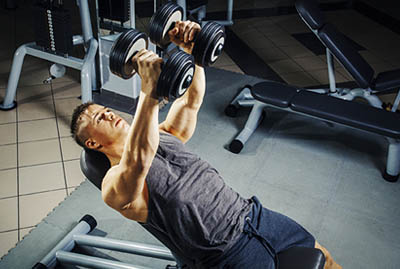If You Want Your Best Chest, Try these Exercises
June 20, 2016
The skimpier clothes of summertime, like swimsuits and tank tops, give us a chance to focus on areas of our physiques that are more exposed. So let’s focus on our chests.
For men, who might find themselves shirtless, and women who want to look fit in that strapless sundress, giving extra attention to the pectoral muscles is a great idea.
One secret to maximizing your workout’s chest benefits is varying the angle or direction from which you work your pecs. And recognizing that your pectoralis major muscle has an upper and lower portion, while pectoralis minor provides a deeper supporting role.
Ramp up your workout with some of these exercise variations to build your best chest ever.
Reverse Grip Dumbbell Bench Press
Changing your grip is another way to shake up your chest workout and activate other, or more, muscle fibers. If you’re a fan of dumbbell bench presses, you can work the upper portion of your pecs a bit more with an incline bench, or as we’re suggesting here, a reverse (supine) grip.
You can do the same with barbell bench presses as well, of course, and you might be able to lift a bit more with a barbell, too. But the dumbbell bench press can help you discover any imbalances in strength quite easily by your ability to keep the dumbbells even throughout the movement.
How to do it: Get in position for your dumbbell bench presses on the bench with your arms extending over your chest and your hands in reverse, palms facing you. Then slowly control the dumbbells down to your outer chest, then press them back out. Pause for a moment at the upper part of the press, then repeat.
Incline Dumbbell Flye
As mentioned above, the incline bench delivers some beneficial changes to your chest workout. Before altering or progressing basic exercises like this, be sure you have your form down pat.
Variables for the dumbbell flye can go beyond the incline bench as well. For example, try keeping your palms facing forward instead of facing each other, or perform the move with kettlebells instead of dumbbells. Your body responds to the variation!
How to do it: Get in position for your dumbbell flyes on the bench raised to an incline of about 45 degrees. Then control the dumbbells as you open your arms on a wide arc, with slightly bent elbows, then press them back up in front of your chest. Pause for a moment as you contract your chest, then repeat.
Close-Grip Push-Up
What, more push-ups? Mayo Clinic researchers once determined that the activity in pectoralis major is greater with a hand position closer than shoulder width. And the close-grip push-up hits the inner portion of your pecs a little more, too.
Naturally, these push-up get even more intense if you add weight. If you’re a more advanced lifter, it’s a good choice for one last move after you’ve finished your chest workout with free weights.
How to do it: Set up in your push-up position with your hands 6 – 8 inches apart. If you’re going to do weighted push-up, you could try a weighted vest or have a partner place a weight gently on your back between your shoulder blades. Then do controlled push-ups – keep the pace a bit slower, especially on the way down.
Decline Push-Up
Chances are you’re already doing push-ups—it’s an effective classic, but doing push-ups in certain ways effects how much activity the chest muscles see. The distance between your hands matters (see the next round below), and so does the angle of your body pushing against gravity.
By elevating your legs behind you, you create a more intense movement as you overcome gravity pushing back up. As a compliment to the close-grip push-up, the decline push-up further targets the outer portion of pectoralis major.
How to do it: Set up in your push-up position with your hands shoulder-width apart, and place your feet on a bench, or box, or other sturdy elevated structure behind you (if you’re out in the woods, you could use a boulder or a tree trunk, for example). Then do controlled push-ups – be careful not to sag your back, and know when to quit so you protect your face from the floor!